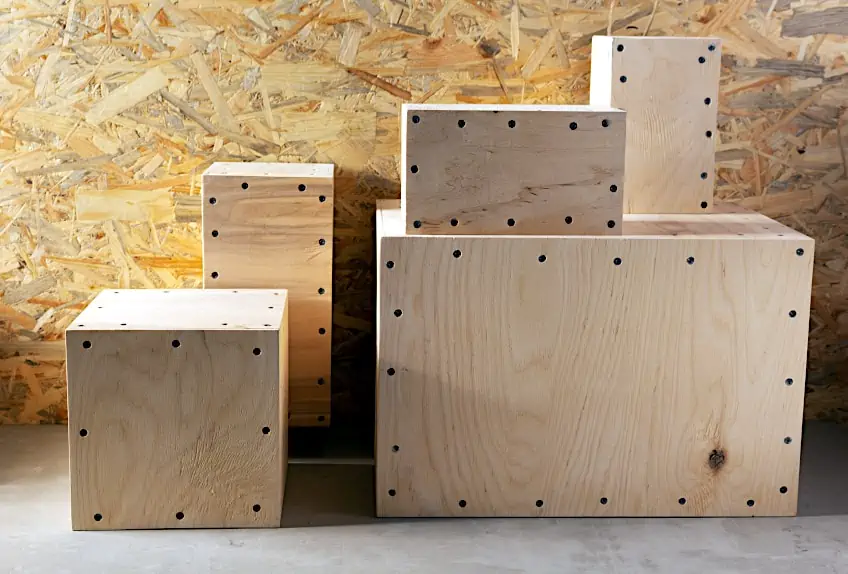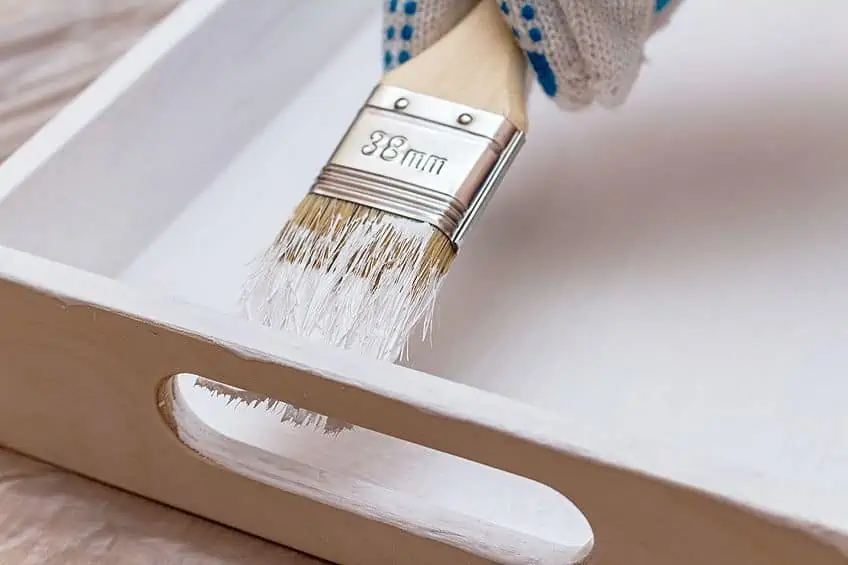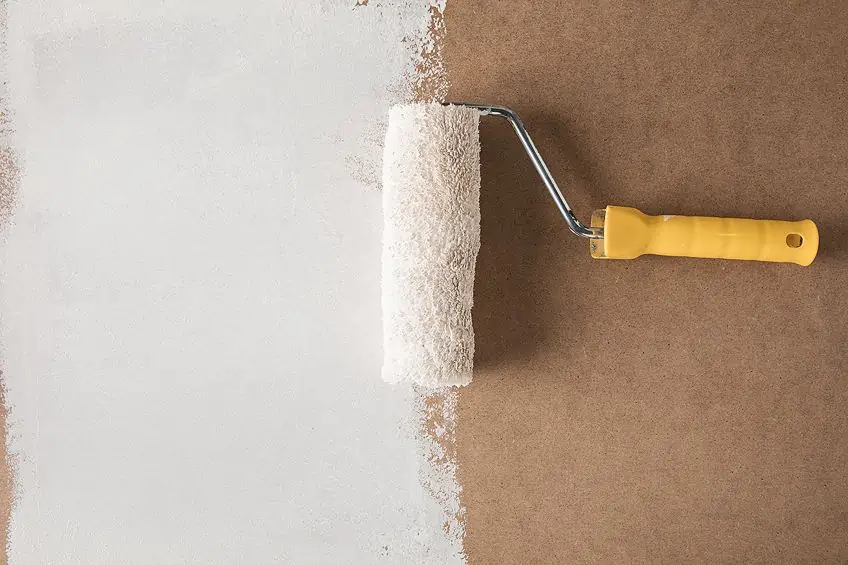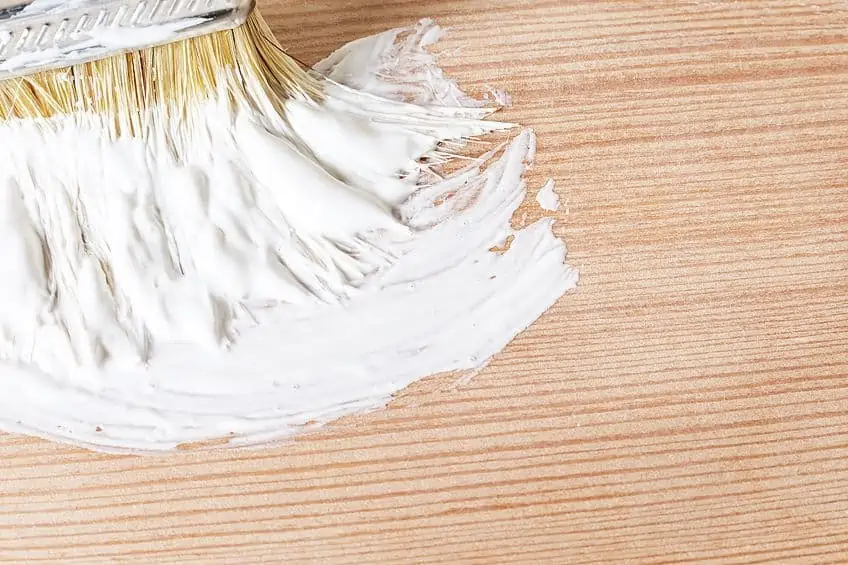How to Paint Plywood – Best Paints to Use on Plywood
This post may contain affiliate links. We may earn a small commission from purchases made through them, at no additional cost to you.
Painted plywood can look great, whether you are creating a new piece of furniture or decorative item from scratch. Perhaps you have an even larger project in mind, such as painting your kitchen cabinets or plywood floors. To get the best finish, you have to have the correct tools, the best paint for plywood, and the knowledge of how to paint plywood. As with most painting projects, preparation of the surface is key. To help, we have put together this basic guide for you.
Table of Contents
What Is Plywood?
Plywood is a widely used, engineered, multi-purpose, wood-based panel. The product is made from thin veneers of wood and binders, which have been packed and pressed together, and then heated to form the panels. The composite panels are quite strong and come in different amounts of layers or plies. Three-ply is the minimum, while added layers are even better.

There are also different grades of plywood, which refers to the appearance of the plywood, and comes in grades from grade A to grade D. When painting plywood, the best options would be your grade A or B. However, the choice also depends on your budget. So, when working on a home improvement project, it is a good idea to know beforehand what your needs are.
Higher-grade plywood provides a cleaner appearance and smooth surface that has no knots. The lower grade plywood will have defects and knots, but these can also be used for painting, you simply have to fill these defects and prepare the plywood more thoroughly before painting. If you choose the lower grade plywood, the extra effort it takes for preparation is essential, but absolutely worth it if you want to achieve a good finish.

So, when selecting plywood, there are different kinds, made from various types of wood. You need to consider the type of plywood and best paint for plywood, depending on your specific needs. You have your first-class plywood veneers, which are mainly your hardwoods like Oak, Mahogany, Maple, or Beech. These are stronger, more durable, and water-resistant.

However, these are rather expensive, and if it is a simple do-it-yourself project, you might want to consider something cheaper. The cheaper option for painted plywood is the softwood plywood products, which are made from Pine, Spruce, Redwood, Cedar, and others.
How difficult is it to paint plywood? Painting plywood is just like painting any other wood surface. As with all kinds of wood, before painting, to finish plywood properly, you need to prepare the surface correctly. There are some exceptions, as you do get plywood that comes already finished. For example, phenolic plywood and plywood with a laminated finish.
What Types of Paint Are Best for Plywood?
Painted plywood is fairly easy to do, and the least expensive way to finish plywood. Also, you can use your preferred color. The type of paint for plywood is influenced by what you want to achieve and what finish you are looking for. The paints to consider include the following:
- Latex paints
- Chalk paints
- Acrylic paints
- Enamel or acrylic enamel paints
- Alkyd enamel paint
The best paint for plywood is your acrylic latex paint. This is because it is water-based, durable, and easy to clean up, and you can wash the surface once the paint has dried. Acrylic latex paints are more flexible than your enamel paints, which means they are less likely to chip and produce a smoother surface. You can also decide on a semi-gloss or satin finish. Many prefer using semi-gloss paint on cabinets and doors as it is more durable. A satin finish will require a topcoat as it is not as durable and needs more protection.

Another choice of paints for plywood is chalk and acrylic paints. However, these will need a sealer once you have finished painting. If you do not, the paint will wear out much quicker, and you will need to do more touch-ups. Acrylic paints and primers are better used on art plywood projects and not for something that requires more heavy-duty paints, such as acrylic latex paints.
You can also get a semi-gloss finish with acrylic enamel paint. For an even glossier finish, you want to consider an oil-based enamel paint, which will need a primer before you begin painting. The enamel paints can be used on surfaces that will have to deal with larger amounts of wear and tear, or where there will be a lot of water.

You also get alkyd enamel paint, which is tougher than oil-based paints and can be used where durability is needed. This paint is not commonly found on walls but is rather used on wood or metal surfaces. For a really durable option, you may also want to look at epoxy paints.
Choosing the Best Paint for Plywood
There are a few things to take note of before you purchase your plywood paint. The first is the paint finish, we have already mentioned this above. There are many choices when it comes to painting finishes or sheens, but the more common options are your gloss, semi-gloss, and satin finish. The chalk paints offer more of a matte or flat finish. The finish will be your final coat and what everybody will see, so you should choose the one that best suits your project. Below are two more things to consider when choosing your paint.

The Amount of Paint Needed
Does your project require a lot of paint, like a floor, or is it something smaller? Most paints come in gallons and can usually cover quite a large space. However, you might need more paint if a second coat is required. So, when calculating how much paint you need take this into account as well as your square footage.

Do You Need a Primer Before Painting?
Most painters would recommend priming in all cases, as it helps the paint to adhere better to surfaces and you will use less paint, which means you can save money. To get a smooth surface on plywood, it is best to always prime. You might also need to apply a sealer or primer/sealer.

Applying a primer might take more time and cost more, but if you do not, it could produce a rough finish and an uneven appearance, or even lead to the paint chipping and peeling over time. This is especially true if you are painting lower-grade plywood that has quite a few defects. In this case, you should make sure your primer is of high quality for the best results. A higher-grade plywood product will have fewer imperfections and a smoother, even surface, and you might get away with a lower-quality primer.

How to Paint Plywood
If you have learned anything about painting wood surfaces or any surface for that matter, it is that preparation is key to the best results and finish. Painting plywood can be as simple, or it can also be difficult. To keep it simple, you should follow all the required steps for producing the best finish, which includes using the best primer and paint. Let us first have a look at the supplies you will need for this job.

Supplies for Painting Plywood
You should always gather everything you will be using to paint with, so you do not have to go looking for anything while you are busy. The first step is to prepare your work area, which means you will need something like plastic drop cloths. You should also protect your clothing by wearing a coverall and gloves. Depending on the type of paint you are using, you might also require a mask or respirator, gloves, and eye protection. Below are a few more supplies that you will be using.
- Painter’s tape
- Paintbrush or roller
- Paint tray
- Paint
- Primer
- High-grit sandpaper
- Putty knife and wood filler
- Sealer like polyurethane if added protection is needed (for example, floors)
When choosing brushes, make sure they are good quality brushes, as you do not want bristles falling out into your paint while you are busy. Visible brush strokes could also be a problem. Make sure the brush or roller can be used with the type of paint you have and is the best choice for working on smooth surfaces. A roller is best suited for larger surfaces, while a brush is for smaller, more detailed work. When it comes to drawers or cabinets, you might also want to use an angled brush to get into any difficult corners.

There is also the option of spray painting plywood, but you will need more equipment like a sprayer, which you can either rent or buy. A sprayer will cover larger areas much more quickly. When it comes to the spray cans, smaller projects are recommended, as you will require several layers of thin paint, and you will use quite a lot of paint.

When using sandpaper, you should have some fine-grit sandpaper as well as coarse-grit sandpaper handy. You can use a sanding block, or an electric sander for larger surfaces. For example, if you are doing a floor, it is best to rent a floor sander to get the job done.
Preparing the Plywood Surface
Once you have placed drop cloths down, you can then mask off any areas you do not want the paint to get on. If you purchased lower-grade plywood, you may have to fill some holes and smooth things out. Before you sand the plywood, take some wood filler, and plug all the holes. Try to see if you can spot or feel any other surface imperfections you might have missed.

You can also round the plywood edges to prevent future chipping and damage. To this, you can either use the length of a screwdriver or fine-grit sandpaper. You can also use an electrical sander if you have done it before.
You can use the putty knife to apply the wood filler and follow the instructions on the packaging. The wood filler should be left to dry overnight. You also do not need to add wood filler if you are not worried about an uneven surface. However, it is needed if you want a nice, smooth, and even finish. When painting plywood edges, if you purchase cut boards, some will have smooth edges. In this case, the edges only need to be lightly sanded along with the other surfaces. However, if the edges are pitted, it can do with some wood filler.

To get a more professional, extremely smooth surface, apply a skim coat of joint compound, which is also known as drywall mud, to the surface and edges. Try to apply the compound as uniformly as you can and then allow this to dry overnight.
How to sand plywood? You can then sand the plywood, starting with the coarser sandpaper like the 100-grit paper, if the surface is quite rough with pronounced imperfections. You can then move to finer grit sandpaper as you go. For example, 180 to 220 grit sandpaper. The whole purpose is to create a smooth surface for the paint. Always do any sanding in a space that is well ventilated.

If you used the joint compound, you should be left with patches of white where the product is working to even out the surface. You might also have to apply another layer of drywall mud if it is low-grade plywood. Allow the coat to dry and then sand to get an even surface. When sanding, it creates a lot of dust, so make sure to use your protective gear.

If you have good-quality plywood that is already smooth, you can simply start with the finer grit sandpaper. Plywood is made from layers of wood, so you should be careful when sanding, not to take too much off. Once you are done sanding, make sure to remove the dust. You can first vacuum the dust-up and then wipe the surface with a cloth.
Priming Plywood
Priming is recommended as it helps the paint to better adhere to the surface and you use a lot less paint overall. Make sure that you match the primer with the type of paint you are using, which would likely be water-based but you can also get oil-based.

Plywood primer can now be used for painting plywood edges, which can be applied with a brush or roller. Smaller and more detailed areas are best applied with a brush. If you are painting a floor surface, you can paint the edges and then paint a border of about 10 cm, so that there is enough space from the edge when using a roller. You can also tape the edges for a neater application.

You can also get better quality acrylic latex paints that are both a primer and paint in one, so a separate primer product is unnecessary. Although, you might use a lot more paint on your first coat, as it will soak into the wood where it will seal the pores. When using a primer, this allows for a smoother finish, and the grain should not be visible through the paint. When it comes to enamel and oil-based paints, a primer is necessary, as these paints do not dry properly. So, the primer prevents the paint from being absorbed and helps the paint to dry properly.

When applying the primer, use smooth and even strokes, which will help prevent any drips and streaks. Cover the entire area, and once dry, inspect for any flaws. If there are any, you can simply apply more putty, sand the area, and then touch up with some primer before you move on. You can then use some 180-grit sandpaper to sand the primed surface lightly. Remember to read the directions for using the primer, as it should tell you how long to leave the primer to dry and how many coats you should apply.
Painting Plywood
When you have done a good job of preparing and priming the surface, painting should be a breeze, leaving no imperfections once finished. Apply an even, thin coat of paint to the surface, as you did with the primer. Do not worry if you can still see the primer with the first coat, as you are going to apply more layers of paint. It is better to have more thin coats than to apply fewer thicker layers of paint.

Remember to allow each coat of paint to dry properly and then lightly sand with fine-grit paper in-between coats. Also, remove any dust before you paint another layer. You should aim for several thin coats of paint for the best finish.
Again, you should follow the instructions on the paint product. Painting the plywood edges first is advisable, followed by larger areas. So, if you do have some drips of paint, it will be at the edge, which is less visible. If needed, you can then apply a coat of polyurethane or polyacrylic for extra protection. Follow the instructions provided and allow to dry for 48 hours.

Trips and Tricks for Painting Plywood
Painting plywood is a reasonably easy project if you follow all the proper directions. As with anything, there might be a few things that can go wrong, which inevitably leads to a poor painted finish. First, you need a little patience when it comes to painting wood as it sometimes requires several layers of paint, which needs to dry and must then be sanded. Little things like making sure all the dust is cleaned off the surface can play a big role in the final results.
- One of the biggest rules when painting plywood, is preparing the surface properly. This will ensure a strong and smooth finish. Do not skip any parts of preparation or do a half job, as it will only make things more difficult in the long run.
- When purchasing plywood, it is a good idea to look at various sheets as there can be significant differences between them. Always check the edges to check for any holes and gaps.
- Purchase good-quality, high-grade hardwood plywood for best results.
- You can tint your primer as close as possible to the color paint you will be using, which can help to save paint, especially for larger projects. This should only be done for indoor projects.
- Plywood is not the best option when it comes to flooring that will have a high traffic flow, or areas where there is a lot of moisture or water.
- Always work in a well-ventilated area and try to choose paints that have a low odor and fewer volatile organic compounds (VOCs).
- If you do have any drips or paint lines, try using a single-edge razor to remove them.
- Some recommend using an oil-based primer on plywood to prevent the wood from swelling and creating a bumpy surface, which requires a lot of sanding.
- Lower-grade plywood usually has knots, which have resins that can seep through a primer. So, it is best to use a stain-blocking primer.
- Also, choose high-quality brushes and rollers for the job, as you do not want them to fall apart or shed bristles.
- Always read and follow directions on the products you are using.
Painting plywood is similar to painting any other wooden surface, the main thing is to always prepare the surface properly before painting. It also pays to have all your tools ready, and an area to work in that is well-ventilated. Doing all of this should make it easier to paint your plywood perfectly.
View our Painting Plywood web story here.
Frequently Asked Questions
Can You Use Spray Paint on Plywood?
Yes, spray painting plywood is possible and is great for those larger areas. However, you will have to purchase or rent the spray equipment. Smaller spray cans can also be used, but these are better for small projects.
Do You Need a Primer?
Yes, we recommended that you always apply a primer before painting on any wood surface. This not only helps the paint adhere better but can also prevent stains from seeping through and provides a smoother finish.
How to Sand Plywood?
The easiest way to sand plywood is to use 180-grit sandpaper to go over the surface. Once done, if the surface requires more sanding, change to finer-grit sandpaper as you do not want to sand away too much. Sanding is mostly required for lower-grade plywood products that have knots and other imperfections. If you are painting plywood, you will also have to do some sanding after applying filler and between layers of plywood primer and paint. The purpose is to get the surface to be as smooth and even as possible.
Which Plywood Is Best for Painting?
Plywood comes in various grades of hardwood and softwood. They come in grades A through D, A being the best grade of plywood. When painting plywood, a higher-grade veneer hardwood is best. This is because it is more durable, easier to work with, and will provide a smoother paint finish.








